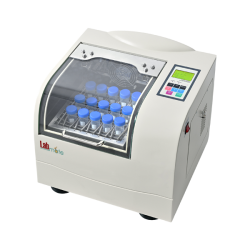
Labmate Bench-top Shaking Incubator LMSI-C201 is a Bench top and floor standing dual-purpose designed incubator having stainless steel chambers with illumination. It provides a constant and consistent shaking with speed range of 30-400/600 RPM. It has an optional refrigeration and temperature setting. It also has a high quality glass window for safety and to view the temperature, time and speed.
Get Quote| Control | P.I.D. (Environmental Scanning Microprocessor) |
| Display | LCD (simultaneous display of working & set parameters)) |
| Convection Mode | Forced Circulation |
| Oscillation Mode | Orbital |
| Drive | Single-shaft balance device |
| Working environment | Temperature: 25°C.Humidity20%-90% |
| Temp. Range | 5°C~60°C |
| Temp. Accuracy | ±0.1°C |
| Temp. Uniformity | ±1°C |
| Speed Range(rpm) | 30-600 RPM |
| Speed Accuracy | ±1 RPM |
| Oscillation Amplitude | Φ0 -50 mm |
| Heater Power | 150 W |
| Timing Range | 0-999.59hr/Continuous |
| Tray Size(mm) | 260 x 260 mm |
| Tray Number | 1 pieces |
| Net Weight | 31 kg |
| Chamber Size | 360x340x280 mm |
| Lid-open Height | 746 mm |
| Overall Dimensions | 440x410x420 mm |
| Power | 280 W |
| Power Supply | AC 200-240V/50-60HZ. Optional: AC110V/60Hz |
| Chamber Material | Polished stainless steel |
| Construction | ABS engineering plastic |
 Benchtop and floor standing dual-purpose design
Benchtop and floor standing dual-purpose design
 P.I.D environmental scanning micro-processing controller
P.I.D environmental scanning micro-processing controller
 ABS construction with LCD display
ABS construction with LCD display
 Single-shaft drive technology
Single-shaft drive technology
 CFC-Free(134A) Refrigeration system
CFC-Free(134A) Refrigeration system
 Durable and no noise
Durable and no noise
 Audio Visual alarming system: High/low limit over temperature, high/low limit over speed alarm, stop-running protection for door opening, electric current leakage and over load protection
Audio Visual alarming system: High/low limit over temperature, high/low limit over speed alarm, stop-running protection for door opening, electric current leakage and over load protection
 Motor over-heat protection
Motor over-heat protection
 Pneumatic spring support for stable lid opening
Pneumatic spring support for stable lid opening
 Programmed power cut-off abnormal temperature
Programmed power cut-off abnormal temperature
 Repeat, increment (step) and 8-segment curve programming setting
Repeat, increment (step) and 8-segment curve programming setting
 60W AC inductive long-life brushless motor, maintenance free
60W AC inductive long-life brushless motor, maintenance free
 Acceleration control circuit ensures soft start, smooth acceleration and safety of samples
Acceleration control circuit ensures soft start, smooth acceleration and safety of samples
 Automatic stop of shaking when door is opened
Automatic stop of shaking when door is opened
| Model No | Particular | Quantity |
| LMSI-C-SA01 | Shaking tray | 1 |
| LMSI-C-SA02 | Flask clamp | 1 |
| Model No | Particular | Quantity |
| LMSI-B-OA01 | Humidity testing/control system | 1 |
| LMSI-B-OA02 | Gas inlet | 1 |
| LMSI-B-OA03 | Illumination system (15000Lux) | 1 |
| LMSI-B-OA04 | UV lamp | 1 |
Get Quote for
Bench-top Shaking Incubator LMSI-C201
Related Products